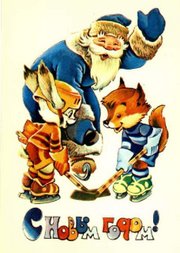Ded Moroz
In the culture of the eastern Slavs the traditional character Ded Moroz (Russian: Дед Мороз) plays a role similar to that of Santa Claus. The literal translation of the name would be Grandfather Frost. However, English-speakers traditionally translate his name as Father Frost.
Ded Moroz brings presents to children. However, unlike the clandestine ways of Santa Claus, he brings them in person, at the celebrations of the New Year, at New Year parties for kids by the New Year Tree. Ded Moroz is accompanied by Snegurochka (Russian: Снегурочка), or 'Snow Maiden', his granddaughter.
The traditional appearance of Ded Moroz has a close resemblance to that of Santa Claus, with his red coat, boots and long white beard. Specifically, Ded Moroz wears a heel-long red fur coat, a semi-round fur hat, and white valenki or high boots (sapogi), silver or red with silver ornament. Unlike Santa Claus, he walks with a long magical staff, does not say "Ho, ho, ho", and drives no reindeer.
The official residence of Ded Moroz in Russia is the town of Veliky Ustyug. The residence of the Belarusian Dzied Maroz is in Belavezhskaya Pushcha.
Contents |
History of Ded Moroz
His roots are in pagan beliefs, but since 19th century his attributes and legend were shaped under literary influences. He, together with Snegurochka, were "fleshed out" from a kind of a winter sprite into what he is now. The fairy tale play Snegurochka by the famous Russian playwright Alexander Ostrovsky was influential in this respect, followed by Rimsky-Korsakov's Snegurochka with libretto based on the play.
Only by the end of the 19th century did Ded Moroz win a "competition" between the various mythical figures who were in charge of New Year presents: Grandfather Nicholas, Santa Claus, Ded Treskun, Morozko, simply Moroz, etc. He perfectly fits the Russian traditions, so that there was a widespread opinion that he has been known to Russians for centuries.
After the Russian Revolution, when in 1920s Bolsheviks started to wage a campaign against religion and superstitions, Ded Moroz and the New Year Tree were banned in 1928, and Ded Moroz was declared "an ally of the priest and kulak".[1]. Joseph Stalin restored the tradition in 1935, after the recommendation of Pavel Postyshev, who had considered the traditions as a tool with which to fight both Christianity and to mobilize the workers.[1] In 1937, Ded Moroz for the first time arrived at the Moscow Palace of Unions. Since this time, an invitation to the New Year Tree at the Palace of Unions became a matter of honor for Soviet children. Several times, the coat of Ded Moroz was changed to not be confused with Santa Claus; it was made blue. Joseph Stalin ordered Palace of Unions' Ded Morozes to wear only blue coats.
Regional differences of Ded Moroz
ex-USSR
There are equivalents of Ded Moroz and Snegurochka all over the former USSR, as well as the countries once in the so-called Soviet bloc.
Bosnia and Herzegovina, Bulgaria, Croatia, Republic of Macedonia, Serbia and Montenegro
In Bosnia and Herzegovina, the person who brings New Year's gifts to kids of all religions is called Djeda Mraz in Bosnian, much alike Деда Мраз (Deda Mraz) in Serbia or Дядо Мраз (Djado Mraz) in Bulgaria. In Former Yugoslav Republic of Macedonia, the name is Дедо Мраз (Dedo Mraz), and in Serbian part of Bosnia and Herzegovina and in Montenegro, the variation of this person's name is Ijekavian Serbian Дједа Мраз (Djeda Mraz), like in Bosnian. In Croati his name is Djed Mraz or Deda Mraz He wears red clothes, just like Father Christmas, but he's not always fat.
Slovenia
In Slovenia he is called Dedek Mraz and is also quite different in appearance from the american Santa Claus. He is slim and wears a grey coat and a round fur cap.
Poland
While there is no traditional analog of Ded Moroz in Polish folklore, there was an attempt to introduce him as Dziadek Mróz during the communist period. In the People's Republic of Poland the figure Dziadek Mróz was used in propaganda, since the traditional Święty Mikołaj (Saint Nicholas, the Polish Santa Claus) was determined to be "ideologically hostile", as part of the campaign against religion, which included elimination of Christmas in favor of New Year. Often officials insisted on using the figure in Polish schools and preschools during celebrations and events for Polish children, instead of Santa Claus in order to give impression of traditional cultural links with Soviet Russia. Despite those efforts, Dziadek Mróz never gained any popular support among the Polish people, and after the fall of communism he disappeared from Poland.[2]
Germany
The Väterchen Frost ("Old Father Frost") character of German folklore is also closely related to the tradition of Ded Moroz, some simularities Ded Moroz also shares with French Père Noël (Grandfather January).
Tatar
In Tatar language he is known as Qış Babay/Кыш Бабай (Winter Grandfather) and is accompanied by Qar Qızı/Кар Кызы (Snow Girl).
See also
- Moş Gerilă (in Romania)
- Christmas in Eastern Europe
References
- ^ a b Karen Petrone, Life Has Become More Joyous, Comrades: Celebrations in the Time of Stalin, Indiana University Press, 200, ISBN 0-253-33768-2, Google Print, p.85
- ^ *(Polish) Dziadek Mróz against Saint Nicholas, last accessed on 11 May 2006
Categories: Christmas characters

